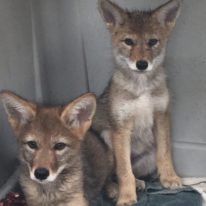Though coyotes often get a bad rap for being marauders and are often labeled as vermin or pests, coyotes serve an important function in keeping an ecological balance. These misunderstood animals keep rodent populations in check which brings them into newly populated areas and freshly plowed fields. As ambassadors for the species our coyotes teach advocacy for predators such as themselves and encourage young learners to appreciate their species.
Coyote Facts – Canis latrans
Habitat: North America, all regions
Lifespan: Wild 6-8 years; Captivity 12-16 years
Diet: Omnivore
Status: Least concern
The coyote, like many canids, is highly adaptable in habitat and opportunistic in diet. Once believed to be always solitary, it may also form a breeding pair or, when larger prey is common, gather as a small hunting pack. Coyotes have a grizzled buff coat that is yellowish on the outer ears, legs, and feet. The shoulders, back, and tail may be tinged black. Food varies from pronghorns, deer, and mountain sheep to fish, carrion, and refuse. The coyote is a rapid sprinter (40 mph/ 65 kph) and often runs down jackrabbits. Its well-known nocturnal howl usually announces an individual’s territory or location to neighbors. Mating occurs from January to March, gestation takes 63 days, and the litter size is 6 to 18 (average 6). The pups are born in a secure den.
The coyote, like many similar species, uses a characteristic pounce to catch small prey, such as mice, in snow or grass. It moves forward slowly, watching and listening intently. Having located the prey, it leaps almost vertically in the air and brings its front feet down onto the animal, pinning it to the ground before killing it with a bite.
Generally, uniformly colored, from frosted grey to rufus-brown, with pale underparts and often greyish or ‘salt-and-pepper’ saddle. Tail is typically infused with dark brown to black hairs, and usually dark-tipped (rarely white-tipped). Melanistic, leucistic, brindled, sable, and blonde individuals occur, particularly in eastern North America, where admixture with domestic dogs is prevalent.
Extremely opportunistic generalist that consumes virtually any edible food source. Vertebrate prey is most important, mainly rodents, lagomorphs, juvenile ungulates and carrion. Mammalian prey is always supplemented by a wide variety of other food sources, especially fruits, seeds, vegetables, grains (including crops), eggs and invertebrates. Domestic pets, especially cats and less so small dogs, are rarely eaten; cats occur in 0-2% of scats collected in urban and suburban studies.
Foraging is normally diuron-crepuscular, but generally nocturnal near humans, particularly where hunted. Scavenges from carnivore (especially gray wolf) kills, human refuse, pet food and bird feeders.
Meet Our Coyotes

Sunny & Blue
Sunny and Blue came to Cat Tales as pups along with some older animals that we agreed to provide a retirement home for. Often times space occupied by older animals is needed for younger litters. Some facilities have to make the choice of euthanasia of older animals to provide areas for young ones that provide funds for the facility. (Everybody likes to see young animals and will pay to do so, not so much the older ones.) We are a retirement home for those older animals and provide quality of life during their latter years. If there are young surplus animals at the placement facilities we may be asked to take them as well. This is how Sunny and Blue came to live with us. Born April 8, 2018
Sunny’s formal name is “Sinawava” – meaning “coyote” in Southern Paiute. Blue’s formal name is “Talapus” – meaning “coyote” in Chinook jargon.


